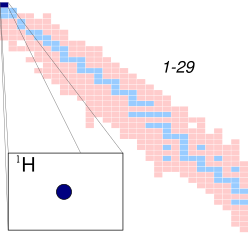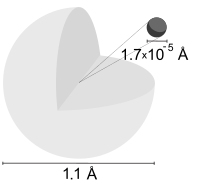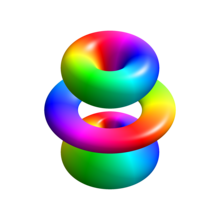From Wikipedia, the free encyclopedia
| Hydrogen atom | |
|---|---|
 Hydrogen atom |
|
| General | |
| Name, symbol | protium,1H |
| Neutrons | 0 |
| Protons | 1 |
| Nuclide data | |
| Natural abundance | 99.985% |
| Isotope mass | 1.007825 u |
| Spin | 1⁄2+ |
| Excess energy | 7288.969± 0.001 keV |
| Binding energy | 0.000± 0.0000 keV |

Depiction of a hydrogen atom showing the diameter as about twice the Bohr model radius. (Image not to scale)
A hydrogen atom is an atom of the chemical element hydrogen. The electrically neutral atom contains a single positively charged proton and a single negatively charged electron bound to the nucleus by the Coulomb force. Atomic hydrogen constitutes about 75% of the elemental (baryonic) mass of the universe.[1]
In everyday life on Earth, isolated hydrogen atoms (usually called "atomic hydrogen" or, more precisely, "monatomic hydrogen") are extremely rare. Instead, hydrogen tends to combine with other atoms in compounds, or with itself to form ordinary (diatomic) hydrogen gas, H2. "Atomic hydrogen" and "hydrogen atom" in ordinary English use have overlapping, yet distinct, meanings. For example, a water molecule contains two hydrogen atoms, but does not contain atomic hydrogen (which would refer to isolated hydrogen atoms).
Production and reactivity
The H–H bond is one of the strongest bonds in chemistry, with a bond dissociation enthalpy of 435.88 kJ/mol at 298 K (25 °C; 77 °F). As a consequence of this strong bond, H2 dissociates to only a minor extent until higher temperatures. At 3,000 K (2,730 °C; 4,940 °F), the degree of dissociation is just 7.85%:[2]- H2 ⇌ 2 H
Isotopes
The most abundant isotope, hydrogen-1, protium, or light hydrogen, contains no neutrons; other isotopes of hydrogen, such as deuterium or tritium, contain one or more neutrons. The formulas below are valid for all three isotopes of hydrogen, but slightly different values of the Rydberg constant (correction formula given below) must be used for each hydrogen isotope.Quantum theoretical analysis
The hydrogen atom has special significance in quantum mechanics and quantum field theory as a simple two-body problem physical system which has yielded many simple analytical solutions in closed-form.In 1913, Niels Bohr obtained the energy levels and spectral frequencies of the hydrogen atom after making a number of simplifying assumptions. These assumptions, the cornerstones of the Bohr model, were not fully correct but did yield fairly correct energy answers (with a relative error in the ground state ionization energy of around α2/4 or around 10−5). In the Bohr model each energy level is identified by an integer quantum number n (now known as the principal quantum number), and has an energy given by
-
 ,
,
The Schrödinger equation also applies to more complicated atoms and molecules. When there is more than one electron or nucleus the solution is not analytical and either computer calculations are necessary or simplifying assumptions must be made.
Since the Schrödinger equation is only valid for non-relativistic Quantum Mechanics, the solutions it yields for the hydrogen atom are not entirely correct. The Dirac equation of relativistic quantum theory improves these solutions (see below).
Solution of Schrödinger equation
The solution of the Schrödinger equation (wave equations) for the hydrogen atom uses the fact that the Coulomb potential produced by the nucleus is isotropic (it is radially symmetric in space and only depends on the distance to the nucleus). Although the resulting energy eigenfunctions (the orbitals) are not necessarily isotropic themselves, their dependence on the angular coordinates follows completely generally from this isotropy of the underlying potential: the eigenstates of the Hamiltonian (that is, the energy eigenstates) can be chosen as simultaneous eigenstates of the angular momentum operator. This corresponds to the fact that angular momentum is conserved in the orbital motion of the electron around the nucleus. Therefore, the energy eigenstates may be classified by two angular momentum quantum numbers, ℓ and m (both are integers). The angular momentum quantum number ℓ = 0, 1, 2, ... determines the magnitude of the angular momentum. The magnetic quantum number m = −ℓ, ..., +ℓ determines the projection of the angular momentum on the (arbitrarily chosen) z-axis.In addition to mathematical expressions for total angular momentum and angular momentum projection of wavefunctions, an expression for the radial dependence of the wave functions must be found. It is only here that the details of the 1/r Coulomb potential enter (leading to Laguerre polynomials in r). This leads to a third quantum number, the principal quantum number n = 1, 2, 3, .... The principal quantum number in hydrogen is related to the atom's total energy.
Note that the maximum value of the angular momentum quantum number is limited by the principal quantum number: it can run only up to n − 1, i.e. ℓ = 0, 1, ..., n − 1.
Due to angular momentum conservation, states of the same ℓ but different m have the same energy (this holds for all problems with rotational symmetry). In addition, for the hydrogen atom, states of the same n but different ℓ are also degenerate (i.e. they have the same energy). However, this is a specific property of hydrogen and is no longer true for more complicated atoms which have a (effective) potential differing from the form 1/r (due to the presence of the inner electrons shielding the nucleus potential).
Taking into account the spin of the electron adds a last quantum number, the projection of the electron's spin angular momentum along the z-axis, which can take on two values. Therefore, any eigenstate of the electron in the hydrogen atom is described fully by four quantum numbers. According to the usual rules of quantum mechanics, the actual state of the electron may be any superposition of these states. This explains also why the choice of z-axis for the directional quantization of the angular momentum vector is immaterial: an orbital of given ℓ and m′ obtained for another preferred axis z′ can always be represented as a suitable superposition of the various states of different m (but same l) that have been obtained for z.
Alternatives to the Schrödinger theory
In the language of Heisenberg's matrix mechanics, the hydrogen atom was first solved by Wolfgang Pauli[3] using a rotational symmetry in four dimension [O(4)-symmetry] generated by the angular momentum and the Laplace–Runge–Lenz vector. By extending the symmetry group O(4) to the dynamical group O(4,2), the entire spectrum and all transitions were embedded in a single irreducible group representation.[4]In 1979 the (non relativistic) hydrogen atom was solved for the first time within Feynman's path integral formulation of quantum mechanics.[5][6] This work greatly extended the range of applicability of Feynman's method.
Mathematical summary of eigenstates of hydrogen atom
In 1928, Paul Dirac found an equation that was fully compatible with Special Relativity, and (as a consequence) made the wave function a 4-component "Dirac spinor" including "up" and "down" spin components, with both positive and "negative" energy (or matter and antimatter). The solution to this equation gave the following results, more accurate than the Schrödinger solution.Energy levels
The energy levels of hydrogen, including fine structure (excluding Lamb shift and hyperfine structure), are given by the Sommerfeld fine structure expression:The value
This constant is often used in atomic physics in the form of the Rydberg unit of energy:
The exact value of the Rydberg constant above assumes that the nucleus is infinitely massive with respect to the electron. For hydrogen-1, hydrogen-2 (deuterium), and hydrogen-3 (tritium) the constant must be slightly modified to use the reduced mass of the system, rather than simply the mass of the electron. However, since the nucleus is much heavier than the electron, the values are nearly the same. The Rydberg constant RM for a hydrogen atom (one electron), R is given by:
 where M is the mass of the atomic nucleus. For hydrogen-1, the quantity
where M is the mass of the atomic nucleus. For hydrogen-1, the quantity  is about 1/1836 (i.e. the electron-to-proton mass ratio). For deuterium and tritium, the ratios are about 1/3670 and 1/5497 respectively. These figures, when added to 1 in the denominator, represent very small corrections in the value of R, and thus only small corrections to all energy levels in corresponding hydrogen isotopes.
is about 1/1836 (i.e. the electron-to-proton mass ratio). For deuterium and tritium, the ratios are about 1/3670 and 1/5497 respectively. These figures, when added to 1 in the denominator, represent very small corrections in the value of R, and thus only small corrections to all energy levels in corresponding hydrogen isotopes.Wavefunction
The normalized position wavefunctions, given in spherical coordinates are:where:
 ,
, is the Bohr radius,
is the Bohr radius, is a generalized Laguerre polynomial of degree n − ℓ − 1, and
is a generalized Laguerre polynomial of degree n − ℓ − 1, and is a spherical harmonic function of degree ℓ and order m. Note that the generalized Laguerre polynomials are defined differently by different authors. The usage here is consistent with the definitions used by Messiah,[8] and Mathematica.[9] In other places, the Laguerre polynomial includes a factor of
is a spherical harmonic function of degree ℓ and order m. Note that the generalized Laguerre polynomials are defined differently by different authors. The usage here is consistent with the definitions used by Messiah,[8] and Mathematica.[9] In other places, the Laguerre polynomial includes a factor of  ,[10] or the generalized Laguerre polynomial appearing in the hydrogen wave function is
,[10] or the generalized Laguerre polynomial appearing in the hydrogen wave function is  instead.[11]
instead.[11]
 is the representation of the wavefunction
is the representation of the wavefunction  in Dirac notation, and
in Dirac notation, and  is the Kronecker delta function.[12]
is the Kronecker delta function.[12]Angular momentum
The eigenvalues for Angular momentum operator:Visualizing the hydrogen electron orbitals

Probability densities through the xz-plane for the electron at different quantum numbers (ℓ, across top; n, down side; m = 0)
The image to the right shows the first few hydrogen atom orbitals (energy eigenfunctions). These are cross-sections of the probability density that are color-coded (black represents zero density and white represents the highest density). The angular momentum (orbital) quantum number ℓ is denoted in each column, using the usual spectroscopic letter code (s means ℓ = 0, p means ℓ = 1, d means ℓ = 2). The main (principal) quantum number n (= 1, 2, 3, ...) is marked to the right of each row. For all pictures the magnetic quantum number m has been set to 0, and the cross-sectional plane is the xz-plane (z is the vertical axis). The probability density in three-dimensional space is obtained by rotating the one shown here around the z-axis.
The "ground state", i.e. the state of lowest energy, in which the electron is usually found, is the first one, the 1s state (principal quantum level n = 1, ℓ = 0).
An image with more orbitals is also available (up to higher numbers n and ℓ).
Black lines occur in each but the first orbital: these are the nodes of the wavefunction, i.e. where the probability density is zero. (More precisely, the nodes are spherical harmonics that appear as a result of solving Schrödinger's equation in polar coordinates.)
The quantum numbers determine the layout of these nodes.[13] There are:
 total nodes,
total nodes, of which are angular nodes:
of which are angular nodes:
 angular nodes go around the
angular nodes go around the  axis (in the xy plane). (The figure above does not show these nodes since it plots cross-sections through the xz-plane.)
axis (in the xy plane). (The figure above does not show these nodes since it plots cross-sections through the xz-plane.) (the remaining angular nodes) occur on the
(the remaining angular nodes) occur on the  (vertical) axis.
(vertical) axis.
 (the remaining non-angular nodes) are radial nodes.
(the remaining non-angular nodes) are radial nodes.
Features going beyond the Schrödinger solution
There are several important effects that are neglected by the Schrödinger equation and which are responsible for certain small but measurable deviations of the real spectral lines from the predicted ones:- Although the mean speed of the electron in hydrogen is only 1/137th of the speed of light, many modern experiments are sufficiently precise that a complete theoretical explanation requires a fully relativistic treatment of the problem. A relativistic treatment results in a momentum increase of about 1 part in 37,000 for the electron. Since the electron's wavelength is determined by its momentum, orbitals containing higher speed electrons show contraction due to smaller wavelengths.
- Even when there is no external magnetic field, in the inertial frame of the moving electron, the electromagnetic field of the nucleus has a magnetic component. The spin of the electron has an associated magnetic moment which interacts with this magnetic field. This effect is also explained by special relativity, and it leads to the so-called spin-orbit coupling, i.e., an interaction between the electron's orbital motion around the nucleus, and its spin.
- There are always vacuum fluctuations of the electromagnetic field, according to quantum mechanics. Due to such fluctuations degeneracy between states of the same j but different l is lifted, giving them slightly different energies. This has been demonstrated in the famous Lamb-Retherford experiment and was the starting point for the development of the theory of Quantum electrodynamics (which is able to deal with these vacuum fluctuations and employs the famous Feynman diagrams for approximations using perturbation theory). This effect is now called Lamb shift.
Due to the high precision of the theory also very high precision for the experiments is needed, which utilize a frequency comb.
Hydrogen ion
Hydrogen is not found without its electron in ordinary chemistry (room temperatures and pressures), as ionized hydrogen is highly chemically reactive. When ionized hydrogen is written as "H+" as in the solvation of classical acids such as hydrochloric acid, the hydronium ion, H3O+, is meant, not a literal ionized single hydrogen atom. In that case, the acid transfers the proton to H2O to form H3O+.Ionized hydrogen without its electron, or free protons, are common in the interstellar medium, and solar wind.
 ,
,![\begin{array}{rl} E_{j\,n} & = -m_\text{e}c^2\left[1-\left(1+\left[\dfrac{\alpha}{n-j-\frac{1}{2}+\sqrt{\left(j+\frac{1}{2}\right)^2-\alpha^2}}\right]^2\right)^{-1/2}\right] \\ & \approx -\dfrac{m_\text{e}c^2\alpha^2}{2n^2} \left[1 + \dfrac{\alpha^2}{n^2}\left(\dfrac{n}{j+\frac{1}{2}} - \dfrac{3}{4} \right) \right] , \end{array}](http://upload.wikimedia.org/math/9/9/8/998251d06f98441116b0cd50fb1a2ee5.png)



![\psi_{n\ell m}(r,\vartheta,\varphi) = \sqrt {{\left ( \frac{2}{n a_0} \right )}^3 \frac{(n-\ell-1)!}{2n[(n+\ell)!]^3}} e^{- \rho / 2} \rho^{\ell} L_{n-\ell-1}^{2\ell+1}(\rho) Y_{\ell}^{m}(\vartheta, \varphi )](http://upload.wikimedia.org/math/8/f/9/8f9ac5e9291464477c0bee9006172323.png)

 . Electrons in this state are 45% likely to be found within the solid body shown.
. Electrons in this state are 45% likely to be found within the solid body shown. ,
, is the
is the  is a
is a  is a
is a  ,
, instead.
instead.





 total nodes,
total nodes, of which are angular nodes:
of which are angular nodes:
 angular nodes go around the
angular nodes go around the  axis (in the xy plane). (The figure above does not show these nodes since it plots cross-sections through the xz-plane.)
axis (in the xy plane). (The figure above does not show these nodes since it plots cross-sections through the xz-plane.) (the remaining angular nodes) occur on the
(the remaining angular nodes) occur on the  (vertical) axis.
(vertical) axis. (the remaining non-angular nodes) are radial nodes.
(the remaining non-angular nodes) are radial nodes.